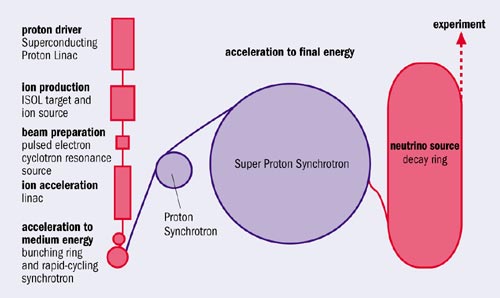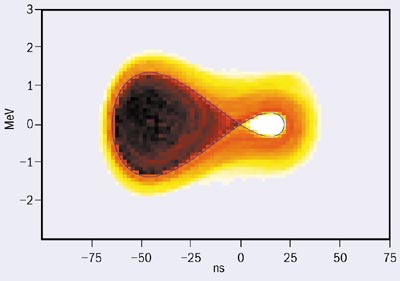Online isotope separation combined with some imaginative accelerator “gymnastics” could provide a high-intensity neutrino beam at CERN. Steve Hancock describes a possible scenario.

Neutrino physics is very much in vogue. The discovery that these elusive particles can oscillate between their three established identities has made the mixing of neutrino flavours more than just “flavour of the month” for theorists and experimentalists alike. Such behaviour introduces the possibility of differences between the matter and antimatter versions of neutrinos. This charge-parity violation, already observed in quarks, may in turn help to explain the disparity between the amounts of matter and antimatter we observe in our universe.
For experimentalists, particle accelerators and nuclear reactors already supplement the neutrinos that come from the Sun or are produced by cosmic rays in the Earth’s atmosphere. However, to investigate properly the new phenomena, the demands on neutrino flux far outstrip supply and some distinctly unconventional sources have been proposed to meet the shortfall. The most recent of these is the “beta-beam” concept, which envisages the production of a pure beam of electron neutrinos (or their antiparticles) through the beta decay of radioactive ions circulating in a high-energy storage ring.
Several factors determine a suitable choice of ion. The flux of neutrinos from the decay ring is determined solely by the rate ions can be accumulated, but the flux at a detector a given distance away also depends on the average energy with which the neutrinos are emitted in the rest frame of the parent ion. Further constraints on ion choice are set by the decay losses that can be tolerated in the accelerator chain and by the decay products that could create long-lived contamination in the low-energy part of that chain. Together these considerations suggest two isotopes of particular interest: 18Ne, giving electron neutrinos, and 6He for antineutrinos. Both can be produced in large quantities by the ISOL (isotope separator online) method, which has been used routinely at CERN for more than 35 years.
Efficient production of the helium isotope requires a two-stage target. Spallation neutrons released in a heavy-metal converter by a very intense proton beam can produce large amounts of 6He in a secondary target of beryllium oxide. The advantage of the converter technology is that the primary proton beam does not impinge directly on the sensitive beryllium oxide. This prolongs the lifetime of the target considerably. The proton-rich neon isotope, 18Ne, can be produced directly by spallation in a suitable target material, e.g. magnesium oxide, but this requires irradiation in a primary proton beam. Consequently, it is possible to produce about a factor of 10 more 6He atoms than 18Ne ones because the proton beam power must be limited for the latter.
The next steps, following isotope production, are to strip off all the remaining electrons and bunch the beam prior to acceleration. It is hoped that both tasks can be accomplished efficiently by a high-frequency (60 GHz) electron cyclotron resonance source. While such a system does not exist today, theoretical calculations are encouraging and a first feasibility test could be envisaged in the near future. Once fully stripped, the ions would be accelerated in a linac to increase their lifetime. The acceleration of high-intensity radioactive ion beams to around 100 MeV/u using a linac has already been studied by the EU-financed EURISOL study.
Further acceleration could be achieved using the existing CERN accelerator infrastructure. However, space-charge effects at injection dictate a beam energy of at least 300 MeV/u before the intensities required for the beta-beam can be digested by CERN’s Proton Synchrotron (PS). This constraint, together with the need for bunches much shorter than those provided by the linac, means that an additional stage of bunching and acceleration is required. The most promising scenario involves multi-turn injection of the linac beam into a rapid-cycling synchrotron, followed by bunching, acceleration and transfer to the PS. This procedure is repeated until all RF buckets are filled and the beam is then accelerated to its top energy and sent to the next synchrotron at CERN, the Super Proton Synchrotron (SPS).

Injection into the SPS is an established space-charge bottleneck, so the bunches must fill the maximum available transverse aperture. It is also foreseen to keep them as long as possible using a new RF system during the early part of acceleration until the standard high-frequency system can take over near the transition energy.
Finally, the decay ring will be an accumulator for the bunches delivered by the accelerator chain. Accumulation is possible because the half-life of the highly relativistic stored ions is more than an order of magnitude longer than the cycling time of the injectors. It is proposed to stack the ions by asymmetric bunch pair merging (figure 2). This relies on a dual-harmonic RF system to combine adjacent bunches in longitudinal phase space such that a fresh, dense bunch is embedded in the core of a much larger one, while diluting the emittance of the beam as little as possible. Each new bunch must be injected in the neighbouring RF bucket to an existing bunch in the stack, but this cannot be done using conventional kicker magnets and septa because of the short risetime that would be required.
An alternative injection scheme exploits the fact that the stack is located at only one azimuth in the decay ring and that the revolution period is relatively long. The new bunches are off-momentum and are injected in a high-dispersion region on a matched dispersion trajectory. This allows a full turn to bring the off-momentum orbit inside the machine at the entry point of the beam. Subsequently, each injected bunch rotates a quarter of a turn in longitudinal phase space until the initial conditions for merging the bunch pairs are met and stacking can proceed.
The aim is to collect an unprecedented 1014 helium ions (5 x 1012 neon ions) in just four bunches, each only 10 nanoseconds long. This is to ensure that enough neutrinos are localized in time sufficiently well to overcome the background issues at the detector in Fréjus some 130 kilometres away in France.








